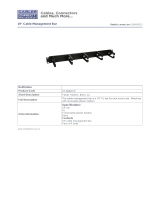
Roche Diagnostics
System Manual · Version 1.0 19
cobas® 4800 System 1 General safety information
System Manual Safety summary
Biohazardous materials
WARNING
Infection by samples and associated materials
Contact with samples containing material of human origin may result in infection. All
materials and mechanical components associated with samples of human origin are
potentially biohazardous. Therefore, universal precautions should be taken when handling
and processing samples.
r Follow standard laboratory practices, especially when working with biohazardous
material.
r Keep the main cover closed and in place while the instrument is operating.
r Do not open the thermal block cycler door during operation.
r When working with the main cover open while the instrument is powered on (e.g., for
cleaning or maintenance), always put the instrument in Maintenance mode or in
Shutdown status first.
r Be sure to wear appropriate protective equipment, including, but not limited to, safety
glasses with side shields, fluid resistant lab coat, and approved disposable gloves.
r Wear a face shield if there is a chance of splash or splatter.
r If any biohazardous material is spilled, wipe it up immediately and apply disinfectant.
r If sample or liquid waste comes into contact with your skin, wash it off immediately
with soap and water, and apply a disinfectant. Consult a physician.
WARNING
Infection and injury due to sharp objects
When wiping sharp objects, use several layers of gauze.
r Be careful to not puncture yourself.
r Be sure to wear appropriate protective equipment, for example gloves.
Waste
WARNING
Infection by biohazardous waste
Liquid and solid waste originates from samples collected in media that inactivate
potentially biohazardous material. However, as with all human-derived solutions, universal
precautions should be taken when handling waste.
Contact with liquid waste or used pipetting tips may result in infection. All materials and
mechanical components that come into contact with waste are potentially biohazardous.
Therefore, universal precautions should be taken when handling waste.
r Be sure to wear protective equipment. Take extra care when working with protective
gloves; these can easily be pierced or cut which can lead to infection.
r If any biohazardous material is spilled, wipe it up immediately and apply disinfectant.
r If liquid waste comes into contact with your skin, wash it off immediately with soap and
water, and apply a disinfectant. Consult a physician immediately.
r Observe the system safety labels as illustrated in section Safety labels on the system
(p. 25)
WARNING
Contamination of the environment by liquid waste and solid waste
The waste generated during the procedure is potentially biohazardous.
r When disposing of any liquid or solid waste, do so according to the appropriate local
regulations.
U For information about disposal, see Disposal (p. 27)


























